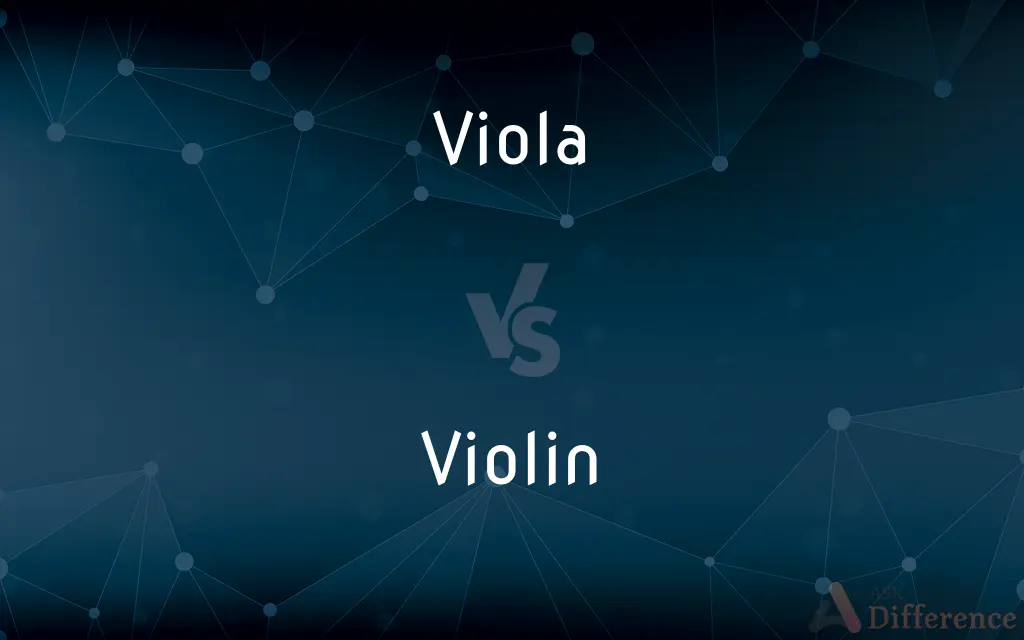Viola vs. Violin — What's the Difference?
By Tayyaba Rehman — Updated on September 25, 2023
Viola and violin are both string instruments; viola is larger, producing a deeper, warmer sound, while violin has a higher, brighter sound.

Difference Between Viola and Violin
Table of Contents
ADVERTISEMENT
Key Differences
Viola and violin, two members of the string family, are often compared due to their similarities in appearance and playing technique. The viola is slightly larger than the violin, resulting in a deeper, warmer, and richer tone. It plays a crucial role in orchestral music, often enriching the middle harmonies and supporting the overall musical texture. It operates primarily in the alto clef, which is distinct from the violin, and its strings are thicker, producing resonant and mellower sounds.
The violin, on the other hand, is renowned for its higher, brighter, and more piercing sound, operating in the treble clef. It usually plays the melody in musical compositions, carrying the principal theme. The violin’s smaller size and lighter strings allow for agility, making it suitable for rapid and intricate musical passages. It is considered one of the most versatile and prominent instruments in music, with a significant presence in various music genres, from classical to folk to jazz.
When exploring musical compositions, the roles of viola and violin are distinctive yet complementary. The viola often provides the harmonic and rhythmic foundation, allowing the violin to soar above with melodic lines. The interplay between the two instruments creates a dynamic musical conversation, where the viola’s rich undertones complement the sparkling brilliance of the violin, adding depth and complexity to the musical piece.
The physical differences between viola and violin also impact the playing techniques. The viola’s larger size requires a different approach in terms of bowing and fingering, and it demands more strength and arm weight from the player. The violin, with its smaller frame, allows for quicker, more delicate movements, necessitating precision and finesse.
Understanding the distinctions and symbiotic relationship between viola and violin is vital for appreciating the richness and diversity of string music. The combination of the viola’s warm, sonorous tones and the violin’s bright, crisp notes contributes to the creation of a harmonious and balanced musical landscape.
ADVERTISEMENT
Comparison Chart
Size and Sound
Larger, produces a deeper, warmer sound.
Smaller, yields a higher, brighter sound.
Role in Composition
Enriches middle harmonies, supports overall texture.
Often carries the principal theme, plays the melody.
Clef
Primarily uses the alto clef.
Uses the treble clef.
String Thickness
Has thicker strings.
Has thinner strings.
Presence in Genres
Predominant in classical music.
Extensively used across various music genres.
Compare with Definitions
Viola
A musical instrument played with a bow, operating primarily in the alto clef.
He skillfully drew the bow across the viola, producing a melodious sound that filled the room.
Violin
A member of the string family that operates in the treble clef and is renowned for its expressive range.
The violin’s expressive tones conveyed a myriad of emotions, bringing the music to life.
Viola
An instrument that typically plays harmonic roles in an orchestra, enriching middle harmonies.
The viola section played a crucial role in balancing the composition’s sonic texture.
Violin
A prominent instrument in orchestras, chamber music, and solo performances, valued for its flexibility.
The violinist's flawless technique showcased the instrument's wide range and dynamic capability.
Viola
A member of the violin family that has thicker strings, requiring more strength to play.
The violist used considerable arm weight to elicit the full, rich sound of the viola.
Violin
A small, high-pitched string instrument, played with a bow, known for its bright, clear sound.
The violin sang with a sweet, melodious voice, captivating the audience.
Viola
A string instrument, larger than a violin, known for its deep, warm sound.
The viola’s rich, resonant tones provided a beautiful harmony to the ensemble.
Violin
A versatile instrument with a leading role in many music genres, usually playing the melody.
The fast, intricate passages demonstrated the violin’s incredible agility and precision.
Viola
An orchestral string instrument with a range between a violin and a cello.
The viola's versatile range allows it to blend seamlessly with both higher and lower string instruments.
Violin
An instrument with thinner strings allowing for rapid, delicate movements and intricate musical passages.
The violin’s delicate strings responded to the lightest touch, creating ethereal, whispering notes.
Viola
The viola ( vee-OH-lə, also UK: vy-OH-lə, Italian: [ˈvjɔːla, viˈɔːla]) is a string instrument that is bowed, plucked, or played with varying techniques. It is slightly larger than a violin and has a lower and deeper sound.
Violin
The violin, sometimes known as a fiddle, is a wooden chordophone (string instrument) in the violin family. Most violins have a hollow wooden body.
Viola
A stringed instrument of the violin family, slightly larger than a violin, tuned a fifth lower, and having a deeper, more sonorous tone.
Violin
A stringed instrument played with a bow, having four strings tuned at intervals of a fifth, an unfretted fingerboard, and a shallower body than the viol and capable of great flexibility in range, tone, and dynamics.
Viola
An organ stop usually of eight-foot or four-foot pitch yielding stringlike tones.
Violin
A small unfretted stringed instrument with four strings tuned (lowest to highest) G-D-A-E, usually held against the chin and played with a bow.
When I play it like this, it's a fiddle; when I play it like this, it's a violin.
Viola
Any of various plants of the genus Viola, which includes the violets and pansies, especially certain ornamental varieties that are usually more compact than pansies and have smaller flowers without a blotch on the petals.
Violin
Any instrument of the violin family, always inclusive of violins, violas, and cellos and sometimes further including the double bass.
The string quartet, one of the most popular groupings in chamber music, is composed entirely of violins: two violins proper, one viola, and one cello.
Viola
(botany) Any of several flowering plants, of the genus Viola, including the violets and pansies.
Violin
The position of a violinist in an orchestra or group.
The first violin often plays the lead melody lines in a string quartet.
Viola
A stringed instrument of the violin family, somewhat larger than a violin, played under the chin, and having a deeper tone.
Violin
(ambitransitive) To play on, or as if on, a violin.
Viola
A person who plays the viola.
Violin
A small instrument with four strings, played with a bow; a fiddle.
Viola
(music) An organ stop having a similar tone.
Violin
Bowed stringed instrument that is the highest member of the violin family; this instrument has four strings and a hollow body and an unfretted fingerboard and is played with a bow
Viola
(music) A 10-string steel-string acoustic guitar, used in Brazilian folk music.
Viola
(music) A berimbau viola, the smallest member of the berimbau used in capoeira music.
Viola
A genus of polypetalous herbaceous plants, including all kinds of violets.
Viola
An instrument in form and use resembling the violin, but larger, and a fifth lower in compass.
Viola
Any of the numerous plants of the genus Viola
Viola
Large genus of flowering herbs of temperate regions
Viola
A bowed stringed instrument slightly larger than a violin, tuned a fifth lower
Common Curiosities
Do the viola and violin read the same music notation?
No, the viola primarily uses the alto clef, while the violin uses the treble clef.
Can violinists switch to viola easily?
The transition can be manageable due to similarities, but adjustments are needed for size and clef differences.
Can a viola be used for solo performances?
Yes, while less common than the violin, the viola can also be used for solo performances, showcasing its rich, warm tones.
Is it harder to play the viola than the violin?
Neither is definitively harder, but each has its challenges, such as the viola’s size and the violin’s intricate passages.
Why is the violin often assigned the melody in compositions?
Its bright, clear sound and agility make it suitable for carrying the principal theme in musical compositions.
Which instrument is more suitable for beginners?
Both have their learning curves, but the violin’s popularity means more available resources for beginners.
Why does the viola have a deeper sound than the violin?
The viola’s larger body and thicker strings produce deeper, resonant tones compared to the violin.
Can the viola play as high as the violin?
While it has a wide range, the viola generally cannot reach the same high pitches as the violin due to its larger size and string thickness.
Are the viola and violin played similarly?
Yes, they share similar playing techniques but differ due to their size and string thickness.
Does the size of the viola affect the playing technique?
Yes, its larger size requires different bowing and fingering techniques and more arm weight from the player.
Is the violin more versatile than the viola?
The violin is more prevalent in various music genres, but both instruments have their unique qualities and roles in music.
Is the violin more popular than the viola?
Yes, the violin is generally more prominent and versatile across various music genres.
Can the viola and violin be part of a string quartet?
Yes, a typical string quartet includes two violins, one viola, and one cello.
Can viola music be transcribed for the violin and vice versa?
Yes, but transposition and adjustment for range differences may be necessary due to their distinct clefs and tonal ranges.
Do viola and violin have the same string tuning?
No, the viola is tuned a fifth lower than the violin.
Share Your Discovery

Previous Comparison
Cabin vs. Cockpit
Next Comparison
Gateway vs. SwitchAuthor Spotlight
Written by
Tayyaba RehmanTayyaba Rehman is a distinguished writer, currently serving as a primary contributor to askdifference.com. As a researcher in semantics and etymology, Tayyaba's passion for the complexity of languages and their distinctions has found a perfect home on the platform. Tayyaba delves into the intricacies of language, distinguishing between commonly confused words and phrases, thereby providing clarity for readers worldwide.
















































